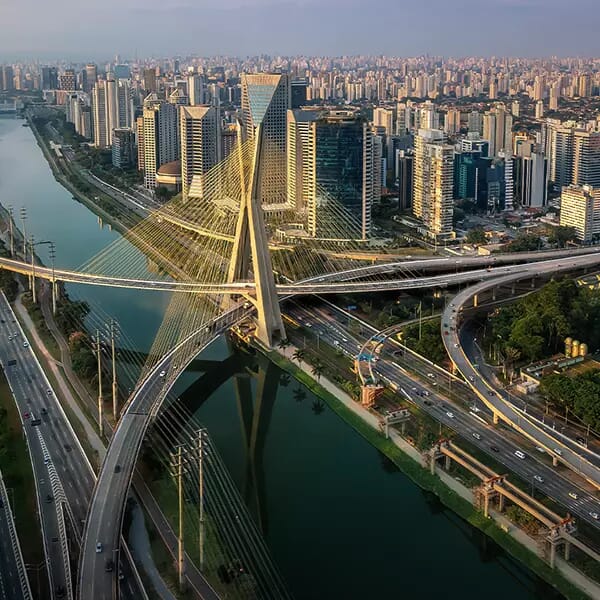 Credit: Baur / Shutterstock
Credit: Baur / ShutterstockFDI Opportunities in the Indian Infrastructure sector
The session to discuss foreign investment opportunities in India's infrastructure sector was widely attended by participants from foreign institutional investment funds, sovereign wealth funds, infrastructure development associations and professionals. The discussion centred around broad themes of: (i) understanding what has (and hasn't) worked in India's favour in attracting foreign investment in infrastructure, (ii) what changes investors, based on their experience, would like to see in the next phase of India's infrastructure growth story; and (iii) what the key opportunities are.
India's Infrastructure Growth Story
The Indian infrastructure sector has played a crucial role in India’s overall development story and has garnered tremendous interest from foreign investors since the post-liberalization push in the 1990s. The initial response to this surge in investment in infrastructure, from a foreign investor perspective, was bitter-sweet. The rewards of investment came riddled with the challenges of regulatory uncertainty from retrospective taxation, to inconsistent policies, to parties unilaterally reneging on contractual arrangements. As a consequence, the results of private investments in infrastructure until five to six years ago remained chequered. Since then however, the Government of India (GoI) has embarked on course-correcting its policies on foreign investment, for instance doing away with retrospective taxation, actively encouraging industry participation in formulating policy and model contracts, as well as setting clear targets for infrastructure growth in the near and long term. While some regulatory and institutional challenges continue to exist and new challenges such as those stemming from India's restrictive model Bilateral Investment Treaty emerge, overall, foreign investors are more upbeat and bullish on India's infrastructure sector than before.
The discussants likened India to other emerging markets such as Brazil (but not so much China) where foreign investors are faced with similarly placed political and economic challenges and therefore, need to account for extra-risk setting in their approach. It was pointed out that while Brazil has its own issues (particularly those affecting monetary policy and volatility), it has a robust regulatory framework for infrastructure development that India can take cues from. It was also noted that China, with its single political party setup and its early experiments with foreign capital, manages to present a stronger mandate for infrastructure development and therefore, attracts a lot more foreign investment compared to India. China has also had a significant head start when it comes to opening up the economy to FDI, which has resulted in widened gap between the FDI inflows to the two countries. However, the Indian government, to its credit, in recent years has opened up sectors that were previously out of bounds for the private sector and in particular, exhibited greater ambition to partner with foreign capital.
The torchbearers - Roads, Renewable Energy and Airports
Infrastructure sub-sectors viz. roads, renewable energy and airports have been leading the charge when it comes to attracting foreign investment in the infrastructure sector in India. The discussion identified several reasons why these infrastructure sub-sectors have managed to perform better at attracting private investment compared to other sub-sectors such as railways, ports, and social infrastructure. The key reasons include: (i) the presence of a stable regulatory framework and sovereign rated institutions such as the National Highways Authority of India that have a proven track record of delivering on private sector expectations resulting in better counter-party risk assessment (when compared to local state government risk); (ii) unambiguous communication by the Government on targets to be achieved for the sector as whole (for instance GOI's stated goal to generate 175 GW of renewable energy by 2022); (iii) robust payment security mechanisms to ensure timely pay-outs to the private investor; (iv) and an overall investor friendly ecosystem - all of which eventually lent to the projects a more 'bankable' status and therefore, provide adequate comfort to foreign investors.
On the contrary, under-performing sub-sectors such as railways, ports and urban social infrastructure continue to be dominated by fiscally strained public sector undertakings which eventually reflects in the poor credit ratings of their projects. The bureaucratic setup of these sub-sectors (particularly the railways) has also been historically wary of private investment in general. It is, however, likely that India's fiscal pressures will eventually force the lackadaisical sub-sectors to reorient their positions with GoI's emerging vision that favourably projects private investment as a necessary supplement to India's infrastructure growth needs.
The National Infrastructure Pipeline, the National Monetisation Pipeline and the future of foreign investments
The National Infrastructure Pipeline (NIP) is an effort to augment India's infrastructure through an earmarked investment of INR 111 lakh crores (~USD 1.5 trillion) in infrastructure development between 2020-25. While bulk of the financing for the NIP (approximately 80% to 85%) is expected to come from a mix of state's budgetary support, financial institutions, private equity and external aid, the balance is expected to come from monetising existing infrastructure assets. Towards this end, the NITI Aayog in consultation with the infrastructure line ministries has developed the National Monetisation Pipeline (NMP). The monetisation models recommended under the NMP include a mix of license and lease formats as well mechanisms of structured finance such as Infrastructure Investment Trusts (InvITs) as opposed to an outright sale.
The discussants were unanimous in the opinion that the success of the NMP will depend on the how the infrastructure assets are structured and whether enough thought is put in by the GoI in making these assets bankable in the long run. For this reason, infrastructure sub-sectors that have traditionally attracted more private investments (e.g., roads, transmission, airports etc.) are likely to take off first as investors often rely on historical performance. The other sub-sectors such as railways which have historically shown reluctance in engaging with private entities will likely see their peripheral activities (and not core operations) open up for investment first in the near term. Further, as long as there is fair risk allocation in these projects and the projects are priced suitably, foreign investors do not appear to have any particular preference for the model of private engagement - license/lease or outright sale.
While the exact modalities of the NMP will be fleshed out in due course, given the short time frame for its implementation (2022-2025) as well as inherent sub-sectoral deficiencies, there's a chance that the NMP will not reach its full potential in the short term. Nonetheless, the NMP is being viewed as a step in the right direction for engaging with the private sector through innovative strategies.
The Government's reliance on brownfield assets under the NMP to attract capital also brings into spotlight the lack of foreign investor confidence in greenfield infrastructure projects in India of late. Barring the exception of renewable energy projects and a few other sectors such as roads and airports, overall, foreign investment in greenfield projects has been limited. To build back investor confidence in greenfield projects, the discussants suggested that the government must up its risk appetite under concessions and look to provide more comfort to the private participants, at least in the initial years of the project, by exploring innovative PPP structures. Till the time such reforms are undertaken, foreign investment in greenfield projects will be limited and will continue to attract only private participants with domain experience in a particular infrastructure sub-sector. Private players participating outside their domain will look to rely on partners (domestic or foreign) who have such domain experience.
Environmental, Social and Governance (ESG) standards, climate change and sustainability
Most foreign investors today have strict internal mandates to ensure high levels of ESG standards for companies they invest in. Industry experience of foreign investors in India reveals that while there used to be some resistance from domestic developers on following such ESG standards, there has now been a wide shift towards their acceptance as an increasing number of developers realize the long term benefits of abiding by such standards. There is, however, room for improvement on fronts such as diversity and inclusion and labour standards and welfare. Foreign investors also revealed the growing influence of climate change and the mandate of sustainable development in their decision-making process, to the extent that a project could become a no-go for them depending on its potential carbon footprint. On this front, doing business in India continues to remain a challenge as climate consciousness is still not evolving at the pace that investors would ideally expect to see.
Trilegal
Trilegal is one of the leading law firms in India, providing innovative and quality legal services across the spectrum of corporate law. With over 400 lawyers spread across Bengaluru, Delhi, Gurugram and Mumbai, the Firm consistently advises many of the world’s leading corporations, financial institutions, and fund houses on their complex and first-to-market transactions. Trilegal has been recognised as the ‘Law Firm of the Decade’ at the RSG Grow India Awards.



